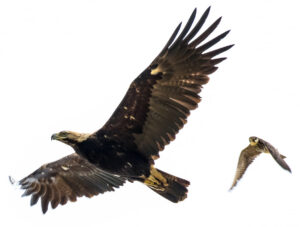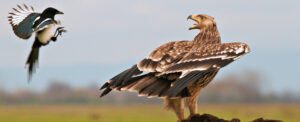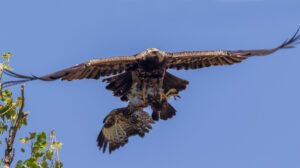Third International Scientific and Practical Conference “Eagles of the Palearctic: Study and Conservation”
Raptors Conservation. Suppl. 2. Proceedings of Conferences
Distribution, Population Status, Ecology, and Conservation of Eastern Imperial Eagle in Thrace Ecoregion (Bulgaria and Turkey)
Demerdzhiev D.A. (Bulgarian Society for the Protection of Birds / Birdlife Bulgaria, Plovdiv;
National Museum of Natural History, Department of Zoology, Sofia, Bulgaria)
Dobrev D.D. (Bulgarian Society for the Protection of Birds / Birdlife Bulgaria, Plovdiv, Bulgaria)
Erkol I.L., Hanay M. (Nature and Culture Association, Kırklareli, Turkey)
Delchev A.G., Dobrev V.D., Stoychev S.A. (Bulgarian Society for the Protection of Birds/ BirdLife Bulgaria, Bulgaria)
Contact:
Dimitar Demerdzhiev dimitar.demerdzhiev@gmail.com
Dobromir Dobrev dobromir.dobrev@bspb.org
Itri Levent Erkol levent.erkol@gmail.com
Mehmet Hanay mehmethanay@gmail.com
Atanas Delchev atanas.delchev@bspb.org
Vladimir Dobrev vladimir.dobrev@bspb.org
Stoycho Stoychev stoycho.stoychev@bspb.org
Recommended citation: Demerdzhiev D.A., Dobrev D.D., Erkol I.L., Hanay M., Delchev A.G., Dobrev V.D., Stoychev S.A. Distribution, Population Status, Ecology, and Conservation of Eastern Imperial Eagle in Thrace Ecoregion (Bulgaria and Turkey). – Raptors Conservation. 2023. S2: 287–289. DOI: 10.19074/1814-8654-2023-2-287-289 URL: http://rrrcn.ru/en/archives/35089
The Thrace geographical region comprises territories of three states and covers an area of about 70,000 km2. At the end of the 19th century, the Eastern Imperial Eagle (Aquila heliaca) was widespread throughout the region, occupying a variety of habitats. The mid-20th century marked the beginning of its dramatic decline, and in the latter half of the century the birds breeding in Northern Thrace amounted to 15–20 pairs, Eastern Thrace harbored scattered pairs along the lower reaches of the Maritsa River, while in Western Thrace the population was estimated at 6–10 pairs only. Since 2005, the intensive conservation activities implemented in Bulgaria have improved the status of the Eastern Imperial Eagle in Northern Thrace. At the same time, in Western Thrace (the Greece), only one pair was confirmed in Dadia National Park. Since 2008, intensive field research in European Turkey identified an abundant and stable population of the species. 63 different breeding territories were established in Bulgaria, while in European Turkey the number of identified breeding territories was 64. Most of the pairs were distributed in the European Green Belt area, along the former Iron Curtain, where human access had been strictly limited, thus preserving extremely rich biodiversity. Based on a long-term population survey of this species in Bulgaria and European Turkey, we estimated this subpopulation of the species at about 110–120 breeding pairs. Breeding of several pairs in Greece, in the Greece-Turkey border area, along the Evros River, is also possible. The Thracian sub-population of the Eastern Imperial Eagle is gradually increasing. The main threats are electrocution, poisoning, habitat destruction, shooting, disturbance, and food depletion. In Bulgaria the main conservation actions include: insulation of hazardous electric poles, purchase of land plots and their subsequent management as pastures, construction of artificial nests, restoration of breeding habitats through Poplar planting, supplementary feeding of pairs during the breeding and the wintering periods, guarding of nests at risk, satellite tracking, implementation of educational programs with children and local communities. Actions are needed to mitigate the limiting factors in European Turkey, as well as to study the status of the species in Northern Greece. International cooperation would guarantee the stability of the Thracian sub-population of the Eastern Imperial Eagle.



